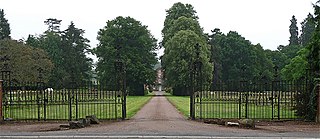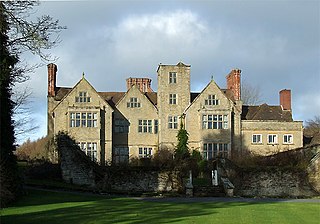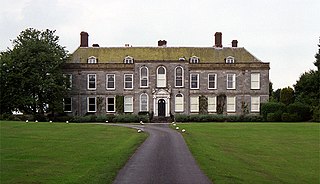
Longford Hall is a large country house in Longford, a village in Shropshire, England near the town of Newport.

Longford Hall is a large country house in Longford, a village in Shropshire, England near the town of Newport.
Longford Hall was built in 1275 by Adam de Brompton and owned by the Earl of Shrewsbury. In April 1644 it was captured by Royalists and subsequently demolished. The present house was built on the site 1794-97 by Colonel Ralph Leeke and designed by Joseph Bonomi. [1] Leeke was a political agent of the British East India Company, the architect had worked with Robert and James Adam. The hall is Grade II* listed with English Heritage. [2]
The hall is placed on top of a low rise and looks over farmland towards the Lilleshall Monument which is surrounded by burials.[ citation needed ] As with many such buildings, the first 100 feet in front of the hall are manicured grass, bordered by a ha-ha which prevented animals from entering. There is a small series of gardens, including a "quad". Behind the hall are a selection of buildings around a central square containing a dovecote which once formed the farm supporting the estate. These buildings were renovated and sensitively converted into housing between 2001 and 2004. The central dovecote is circular and forms an unusual dwelling.
The hall and lands are currently owned by Haberdashers’ Adams School and are used by them as the school's junior boarding house and sports fields. [3] Some land was sold off in 2000 for private housing – now the "Longford Park" housing estate. To get between the school and the hall, one travels approximately one mile along Longford Road.
Across the playing fields, approximately 500 metres, is the Longford Lake. This large artificial pool is used for private fishing by the school and holds a wide variety of fish, including carp.
The 1st Marquess of Abergavenny (1826-1915), whose mother Caroline was a daughter of Ralph Leeke, was born here. [4]
The mansion was rented from 1894 by businessman and Conservative politician Edward Brocklehurst Fielden (1857-1942) before he bought and moved to Condover Hall. [5] [6]
Boarding House Masters at Longford Hall have included:

Newport is a market town in the borough of Telford and Wrekin in Shropshire, England. It lies 7 miles (11 km) north-east of Telford town centre, 12 miles (19 km) west of Stafford, and is near the Shropshire-Staffordshire border. The 2001 census recorded 10,814 people living in the town's parish, which rose to 11,387 by the 2011 census.

Haberdashers' Adams Grammar School is a selective grammar school for high-achieving boys aged 11-18 and girls aged 16-18 with state boarding for boys only, located in Newport, Shropshire, offering day and boarding education. Current (2021) boarding fees are £12,144 per year and £13,644 per year for overseas students It was founded in 1656 by William Adams, a wealthy member of the Worshipful Company of Haberdashers. In January 2018, the school changed its name to Haberdashers’ Adams, replacing the previous name, Adams' Grammar School (AGS). The school is commonly referred to as Adams Grammar whilst they market themselves as 'Haberdashers' Adams'. From 2024, the school will go fully co-ed admitting girls into Year 7.

Arbury Hall is a Grade I listed country house in Nuneaton, Warwickshire, England, and the ancestral home of the Newdigate family, later the Newdigate-Newdegate and Fitzroy-Newdegate families.

Knighton is a hamlet part of the parish of Adbaston in the county of Staffordshire, England.

Pitchford is a small village in the English county of Shropshire. It is located between Cantlop and Acton Burnell and stands on an affluent of the River Severn. Pitchford takes its name from a bituminous spring/pitch in the village, located near The Row Brook.

Cound is a village and civil parish on the west bank of the River Severn in the English county of Shropshire, about 7 miles south east of the county town Shrewsbury. Once a busy and industrious river port Cound has now reverted to a quiet rural community and dormitory village, for commuters to the commercial centres of Shrewsbury and Telford.

Ferney Hall is a mid-Victorian-era mansion house situated at Onibury, Shropshire, England. It is a Grade II listed building. The hall is listed Grade II on the National Heritage List for England and its gardens are also Grade II listed on the Register of Historic Parks and Gardens.

Adcote School is a non-selective independent day and boarding school for girls, located in the village of Little Ness, 5 miles (8.0 km) northwest of Shrewsbury, Shropshire, England. The school was founded in 1907, and is set in a Grade I listed country house built in 1879 for Rebecca Darby, the widow of Alfred Darby I (1807–52) and a great niece of Abraham Darby. The Darbys were the iron-master family who built Ironbridge. The school has a Junior School that takes girls aged 7 to 11, a Senior School for girls aged 11 to 16 and a Sixth Form taking girls from 16 to 19.

Apley Hall is an English Gothic Revival house located in the parish of Stockton near Bridgnorth, Shropshire. The building was completed in 1811 with adjoining property of 180 acres (0.73 km2) of private parkland beside the River Severn. It was once home to the Whitmore & Foster families. The Hall is a Grade II* listed building claimed as one of the largest in the county of Shropshire.

Longford is a village and former civil parish, now in the parish of Church Aston, in the Telford and Wrekin district, in the ceremonial county of Shropshire, England. It is near the town of Newport. In 1961 the parish had a population of 102. On 1 April 1988 the parish was abolished and merged with Church Aston. Roman coins and medieval artifacts have been discovered in the village and it was listed in Domesday Book in 1086 with a population of 23 households, 13.5 plough lands and a mill. The historic manor covers 1,306 acres and includes the townships of Brockton and Stockton. Sites of historic importance include: Longford Hall, a late 16th-century dovecote, Church of St Mary, 13th century Talbot Chapel, remains of a mill race and several farm buildings.

Eastcote House Gardens is an area of public parkland in Eastcote, within the London Borough of Hillingdon. The site covers 3.63 hectares and incorporates the walled garden, dovecote and coach house of Eastcote House. The house was demolished in 1964 by the then Ruislip-Northwood Urban District Council (RNUDC), one of the predecessors of the London Borough of Hillingdon which was formed the following year. At the public's request, the garden and outbuildings were retained and are now maintained by a group of volunteers, the Friends of Eastcote House Gardens, in partnership with the local authority.

Henley Hall is a building of historical significance and is listed on the English Heritage Register. It was built in about 1610 by the Powys family and then substantially changed in 1772. Additions were again made in the late 19th century. It is a generally a three-storey building in brick with a slate roof. Flanking wings were added at both ends of the original linear building c. 1772 and further major extensions carried out in 1875 and 1907. The hall is surrounded by landscaped and formal gardens covering some 60 hectares. The hall itself is listed grade II* and the orangery, outbuildings, dovecote and Bitterley main gate are listed Grade II. It is situated 2.5 miles (4.0 km) northeast of Ludlow town centre, just off the A4117 road to Cleobury Mortimer. The Ledwyche Brook flows by the estate.

Moulsecoomb Place is a large 18th-century house on Lewes Road in the Moulsecoomb area of the English coastal city of Brighton and Hove. Originally a farmhouse based in an agricultural area in the parish of Patcham, north of Brighton, it was bought and extensively remodelled in 1790 for a long-established local family. It was their seat for over 100 years, but the Neoclassical-style mansion and its grounds were bought by the local council in the interwar period when Moulsecoomb was transformed into a major council estate. Subsequent uses have varied, and Moulsecoomb Place later became part of the University of Brighton's range of buildings. Student housing has been built to the rear; but much of the grounds, the house itself and a much older cottage and barn attached to the rear have been preserved. The house is a Grade II Listed building.

Moseley Hall is a Grade II listed 18th-century country house which was situated in parkland in Moseley, Birmingham. The hall itself is now part of Moseley Hall Hospital and much of the surrounding estate has been developed for roads and housing.

Millichope Park is a 19th-century country house in Munslow, Shropshire, England, some 5 miles south-east of Church Stretton.

Shipton Hall is a large Elizabethan country house in the village of Shipton, Shropshire, England, which lies in the Corvedale valley some 7 miles south-west of Much Wenlock. It is a Grade I listed building.

Aldenham Park, also known as Aldenham Hall, is a late 17th-century country house in Morville, near Bridgnorth, Shropshire, England which stands in 12 hectares of parkland. It is a Grade II* listed building.

Shipton is a small village in Shropshire, England.

Church Aston is a civil parish in the district of Telford and Wrekin, Shropshire, England. It contains 22 listed buildings that are recorded in the National Heritage List for England. Of these, three are listed at Grade II*, the middle of the three grades, and the others are at Grade II, the lowest grade. The parish contains the villages of Church Aston and Longford, part of Cheswell, and the surrounding countryside. At Longford, the main building is Longford Hall, a country house which is listed, together with a number of associated structures. Also in this village is a church and the surviving chancel of another church, both of which are listed. Elsewhere most of the listed buildings are houses, cottages, and farm buildings, some of which are timber framed and date from the 17th century, and there is another listed church in Church Aston.